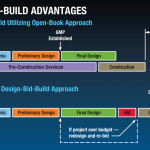News
Flexibility Starts with Design-Build

By Randy Pope, PE, and Neal Angrisano, AIA, NCARB
Airport projects are often saddled with tight time and budget constraints. Or they may have a complex scope or difficult existing conditions. Projects like these can often reap benefits from the flexibility of design-build delivery, expediting the completion of a facility with efficiency and high quality.
Design-build is a method of project delivery in which one entity — the integrated design-build team — works under a single contract with the airport or airline to provide design and construction services: one entity, one contract, one unified flow of work from initial concept through completion. Design-build is an alternative to design-bid-build. Under the latter approach, design and construction responsibilities are split — separate entities, separate contracts, separate work.
Advantages of Design-Build
Faster Delivery
Collaborative project management means work is completed faster with fewer problems. Design-build projects can be completed in a shorter time because bid time is reduced, scheduling for the project can begin before the design is finalized, potential construction problems are uncovered early, and enhanced communication keeps everything moving.
Construction activities can begin well in advance of design completion. For example, the designer can size major, long-lead-time equipment, allowing orders to be placed before the final detailed design is complete. Or a site civil construction package can be purchased and started before the final details of the interior design have been defined. Similarly, the foundation work might also be issued in its own early package.
Cost Savings
An integrated team is geared toward efficiency and innovation. Communicating the cost implications of design decisions helps the airport play a key role in arriving at the final project price. Once the scope of work has been finalized, the project costs are clearly defined and controlled by the design-build firm.
Better Quality
Design-builders meet performance needs, not minimum design requirements, often developing innovations to deliver a better project than initially envisioned. The design-build method helps to remove ambiguity that may arise in material and construction specifications. Since the designer, engineer and builder are from the same firm, the focus remains on protecting the clients’ interest.
Singular Responsibility
One entity is held accountable for cost, schedule and performance. With the undivided accountability, responsibility for defects or non-performance cannot shift to another party. The design-build approach provides a single source of accountability for your entire project.
Enhanced Communication
Specific design and construction details are being developed throughout the process, and the focus remains on owner value. Simultaneously working with construction and design professionals opens up communication, maximizing the potential for problems to be discovered before the project starts.
Decreased Administrative Burden
Value to owners is increased because they are able to focus on their business while all the design and construction needs are handled through one source. Instead of back-and-forth communication between the architect/owner and owner/contractor, it is now streamlined to a single point of contact.
Reduced Risk
Design-build companies eliminate the additional costs that come with errors in planning or construction because only one company owns responsibility. In a design-bid-build situation, blame can be continually shifted resulting in costly delays, change orders and restarting work.
Whether it is a terminal building, runway, integrated information technology and specialty systems, or any other utility or facility at your airport, a design-build approach streamlines project delivery through a single contract between you and your design-build team. This simple but fundamental difference can save money and time by transforming the relationship between designers and builders into an alliance which fosters collaboration and teamwork.
In today’s fast-paced aviation environment, it is often necessary to deliver your project as soon as possible to support your mission. An integrated design-build approach can give you the flexibility to accomplish more of your goals.
– See more at: http://www.burnsmcd.com/Aviation-Special-Report/Article/Flexibility-Starts-with-Design-Build#sthash.dCRaxSu5.dpuf





